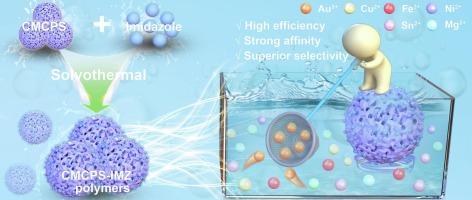一种定制的富氮聚合物,用于从废弃印刷电路板中高效和选择性地捕获金
IF 7.1
2区 环境科学与生态学
Q1 ENGINEERING, ENVIRONMENTAL
引用次数: 0
摘要
从电子废弃物中高效、选择性地回收黄金是可持续利用现有稀有金属资源的理想途径。本研究采用溶剂热法设计和合成了一种巧妙的基于唑功能化聚合物(CMCPS-IMZ)的正电荷陷阱,用于精确捕获金配合物离子。通过在CMCPS表面加入含氮杂环基团,其多孔结构和大表面积促进了金结合位点的形成,从而提高了吸附效率。具体来说,CMCPS-IMZ表现出优异的Au(III)吸附性能,最大吸附量为323.08 mg/g,符合准一级动力学和Freundlich等温模型。理论计算和实验分析表明,CMCPS-IMZ上RNH+基团与AuCl4-之间的静电相互作用是实现高效金回收的主要动力,并参与弱分子间相互作用。此外,CMCPS-IMZ在使用0.5 M SC(NH2)2作为理想洗脱液的多次吸附-解吸循环中表现出显著的稳定性,强调了其作为贵金属回收的强大和可持续平台的潜力。值得注意的是,CMCPS-IMZ微球在实际电子垃圾渗滤液中,即使存在高浓度干扰离子,金的萃取效率也超过93.33%。这项工作为离子亲和力和选择性的本质提供了有价值的见解,为合理设计具有定制结合位点的高级吸附剂提供了指导,以实现靶向离子捕获。本文章由计算机程序翻译,如有差异,请以英文原文为准。

A tailored nitrogen-rich polymer for highly efficient and selective capture of gold from waste printed circuit boards
Achieving efficient and selective gold recovery from electronic waste is a desirable approach for the sustainable utilization of existing rare metal resources. In this study, an ingenious positively charged trap based on azole-functionalized polymer (CMCPS-IMZ) was strategically designed and synthesized via solvothermal method for the precise capture of gold complex ions. By incorporating nitrogen-containing heterocyclic groups onto the CMCPS surface, the porous structure and large surface area promoted the formation of gold-binding sites, thereby enhancing adsorption efficiency. Specifically, CMCPS-IMZ exhibited exceptional Au(III) adsorption performance, with a maximum loading capacity of 323.08 mg/g, following pseudo-first-order kinetics and Freundlich isotherm models. Theoretical calculations and experimental analysis suggested that the electrostatic interactions between the RNH+ group on CMCPS-IMZ and AuCl4- served as the primary driving force to realize the highly efficient gold recovery, as well as involved in weak intermolecular interactions. Furthermore, CMCPS-IMZ demonstrated remarkable stability over multiple adsorption–desorption cycles using 0.5 M SC(NH2)2 as the ideal eluent, underscoring its potential as a robust and sustainable platform for precious metals recovery. Notably, CMCPS-IMZ microspheres achieved a gold extraction efficiency exceeding 93.33 % even in the presence of high concentrations of interfering ions in actual e-waste leachate. This work provides valuable insights into the nature of ion affinity and selectivity, offering guidance for the rational design of advanced adsorbents with tailored binding sites for targeted ion capture.
求助全文
通过发布文献求助,成功后即可免费获取论文全文。
去求助
来源期刊

Waste management
环境科学-工程:环境
CiteScore
15.60
自引率
6.20%
发文量
492
审稿时长
39 days
期刊介绍:
Waste Management is devoted to the presentation and discussion of information on solid wastes,it covers the entire lifecycle of solid. wastes.
Scope:
Addresses solid wastes in both industrialized and economically developing countries
Covers various types of solid wastes, including:
Municipal (e.g., residential, institutional, commercial, light industrial)
Agricultural
Special (e.g., C and D, healthcare, household hazardous wastes, sewage sludge)
 求助内容:
求助内容: 应助结果提醒方式:
应助结果提醒方式:


